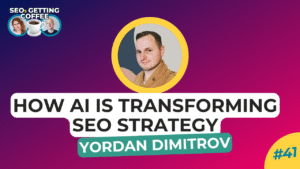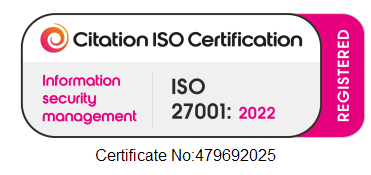Welcome back to another episode of SEOs Getting Coffee! In this episode, hosts Sean and Emina welcome Ali Anderson, the founder of Ali Anderson SEO. Known for her expertise in both B2B and e-commerce SEO, Ali’s path to success includes years working in-house at a B2B SaaS company, agency experience, and now running her consulting business. Today, she shares her perspective on the contrasts between SEO for B2B SaaS companies and e-commerce brands, offering insights that reveal what’s truly unique about optimising for each. Let’s break down the highlights.
Watch Video
B2B vs. E-Commerce SEO Strategies | SEOs Getting Coffee #Episode 31
Understanding B2B vs. E-commerce SEO
B2B and e-commerce SEO are worlds apart, and Ali explains why understanding this difference is essential for success. In B2B, particularly with SaaS, the purchase cycle often involves multiple stakeholders, creating a need for content that appeals to both end-users and decision-makers. This makes the content intricate and layered to support long-term nurturing and relationship-building with prospects.
In e-commerce, however, the focus is more straightforward: convert a single, often one-time visitor into a customer. E-commerce SEO tactics tend to revolve around immediate and tangible interactions, like product pages and category organisation, with a goal of maximising efficiency in a shorter sales funnel.
SEO for B2B: Decision-Makers and Long Sales Cycles
For B2B SEO, Ali emphasises the importance of understanding the layered buying process. B2B SaaS buyers often conduct extensive research over several months before making a final decision. SEO strategies here need to nurture potential clients with educational and supportive content that addresses pain points and showcases the value of the product.
Key strategies Ali highlights:
- Content Depth: B2B audiences often require highly informative content, as Ali explains. Adjusting small elements like title tags alone won’t cut it; B2B SEO often calls for in-depth content that meets the specific needs of different buyers within a business.
- Keyword Strategy for Decision Makers: Ali finds that talking with sales and customer success teams uncovers valuable insights for content. Keyword research can benefit from understanding the language and problems faced by both the product users and those approving budgets.
- Nurturing the Buyer’s Journey: Support content, such as guides, case studies, and help articles, keeps visitors engaged throughout a longer buying process, helping B2B brands stay top-of-mind until the client is ready to buy.
E-commerce SEO: Optimising for Quick Conversions
In contrast, e-commerce SEO is about satisfying a single buyer and encouraging a purchase as quickly as possible. Ali explains that technical SEO is often a top priority here due to the structure of e-commerce websites, which frequently involve extensive collections and product pages.
Strategies Ali recommends:
- Optimising Product and Category Pages: In e-commerce, every detail matters for product and category pages, from titles to meta descriptions to schema markup. These small adjustments can significantly impact rankings.
- Site Architecture and Internal Linking: Ali notes that e-commerce sites often have more complex structures and, therefore, can face issues like crawl budget limitations and orphaned pages. Ensuring that pages are well-organised and that Google can efficiently crawl the site is critical for maintaining search visibility.
- Dealing with Redirects and 404s: Product changes are constant in e-commerce, which means products go out of stock, pages are removed, and new ones are added. Without regular management, 404 errors and broken links can pile up, harming SEO performance. Ali stresses the importance of redirecting high-value pages to similar products to retain the value of backlinks and keep users engaged.
Content Creation for E-commerce: Beyond Blogging
Not every e-commerce brand needs to maintain a blog, Ali says. Content should serve a purpose, whether it’s blog posts, social media, or video content. For brands in industries like beauty or fashion, blog content can answer common questions or offer seasonal advice. However, for more niche e-commerce brands, video or social content may be more effective at connecting with an audience.
Ali’s tips for e-commerce content:
- Social Listening for Trend Insights: Tapping into platforms like TikTok, Reddit, and other social communities provides insight into what potential buyers are interested in, offering direction for content.
- User-Generated Content (UGC): Building community and fostering UGC can create trust and influence purchase decisions. Incorporating customer reviews, product demonstration videos, or social media tags can add authenticity to the brand and boost engagement.
- Leveraging SEO Tools for Audience Insights: Understanding audience behaviour through tools like Hotjar or Google Analytics helps e-commerce brands optimise their sites based on real user interactions, giving them the data they need to make smart content decisions.
The Technical Side of SEO: Comparing B2B and E-commerce
Ali notes that technical SEO for B2B and e-commerce has some overlap, but the priorities can differ. E-commerce sites are often larger, with thousands of pages, which makes technical audits a regular part of the job. Common issues include crawl budget management, indexation problems, and duplicate content. Meanwhile, B2B sites usually have a smaller footprint, and technical SEO can focus more on optimising internal linking or improving page load speed.
Tools Ali recommends for technical SEO:
- Sitebulb: Sitebulb offers comprehensive insights into technical SEO issues, from broken links to duplicate content.
- Hotjar and Google Analytics: Hotjar provides user behaviour insights that can reveal how visitors navigate an e-commerce site, helping SEOs refine page layouts and hierarchy for better conversions.
Tracking and Reporting on SEO Success
Ali acknowledges that measuring SEO success varies between B2B and e-commerce. E-commerce is generally more straightforward, as sales directly reflect SEO efforts. However, B2B can be complex due to the longer sales cycle and multiple touchpoints. Ali suggests a mix of keyword rankings, traffic trends, and conversions as a starting point and emphasises educating clients on the limitations of attribution. Self-reported attribution, as championed by experts like Chris Walker, can also add value by asking clients directly where they discovered the brand.
Room 404: Panicking Over Google Updates
Ali chooses to “banish” the unnecessary stress surrounding Google algorithm updates to Room 404. Rather than stressing over every new change from Google, she recommends focusing on a holistic SEO approach that prioritises customer needs and authentic brand-building.
Conclusion
Ali’s perspective highlights the nuanced nature of SEO for different business models. While both B2B and e-commerce require thoughtful strategies, each has unique requirements, from content creation to technical optimisation and performance tracking. Her approach emphasises a grounded, customer-focused strategy, helping brands navigate SEO without getting lost in the noise of algorithm updates or fleeting SEO trends.
For more insights and in-depth conversations on the latest in SEO and digital marketing strategies, stay stuned for upcoming episodes of “SEOs Getting Coffee.” Subscribe to our channel for regular updates and expert opinions.












